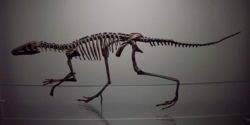Marasuchus
Marasuchus (meaning "Mara crocodile") is a genus of basal dinosauriform archosaur which is possibly synonymous with Lagosuchus.
Specimens of Lagosuchus stored at a museum in San Miguel de Tucuman were considered to be more diagnostic than those of L. talampayensis, and thus they were given a new genus: Marasuchus.
[2] A 2019 study redescribed the original material of Lagosuchus and concluded that it was valid and not readily distinguishable from Marasuchus lilloensis.
[4][3][6] Marasuchus lilloensis is known from several specimens representing most of the animal's skeletal anatomy, although skull material remains limited.
PVL 3870 includes skull material, the entire presacral vertebral column, and a nearly complete hip and hindlimbs.
[2] The referral of PVL 4670 to Marasuchus (or Lagosuchus) is uncertain due to the absence of diagnostic features clearly shared with other specimens.
[8][9] However, a later study by Paul Sereno and Andrea Arcucci (1994) concluded that the original type specimen of Lagosuchus was poorly preserved and undiagnostic.
It was given the specific name Marasuchus lilloensis, based on Romer's species designation for the Tucuman specimen.
[2] Between 1994 and 2019, Marasuchus was considered a more diagnostic and well-described replacement name for the dinosauriform taxon known previously as Lagosuchus.
For example, the basipterygoid processes (a pair of plates at the bottom of the braincase which connect to the roof of the mouth) were short, blade-like, and tilted forwards.
[2] Bonaparte (1975) additionally described squamosal and quadrate bones similar to those of Euparkeria attached to PVL 3872's braincase, although these were not mentioned by later studies.
Also like avemetatarsalians, the upward projecting neural spine of the axis vertebra was expanded and trapezoidal rather than peak-like.
This "gap" between the ilium and ischium along the edge of the pubis becomes more developed in dinosaurs, where it becomes and open cavity that fills up the entire acetabulum (hip socket).
A distinct tab of bone known as an anterior trochanter was present on the outer edge of the femoral head, as with other dinosauriforms and to a lesser extent in other avemetatarsalians.
In addition, Marasuchus also possessed a ridge of bone known as the trochanteric shelf, which branches down from the anterior trochanter and wraps around the shaft of the femur.
A trochanteric shelf is also characteristic of some early dinosaurs, silesaurids, and some specimens of Dromomeron, and a similar structure is also present in aphanosaurs, albeit separate from their equivalent of the anterior trochanter.
As with other dinosauriforms, the tibia (shin bone) has a longitudinal groove edged by a sharp flange at its rear outer corner, near the ankle.
[2] The ankle had two main bones: the larger, boxy astragalus and a smaller calcaneum attached to its outer edge.
In some aspects, the ankle shared features with other dinosauriforms, such as a vertical triangular branch of the astragalus (known as an ascending process) which rises up in front of the tibia.
Although it was not as close as silesaurids such as Silesaurus, Marasuchus is still one of the most completely known avemetatarsalians, assisting knowledge of the early evolution of dinosaur-like characteristics.



